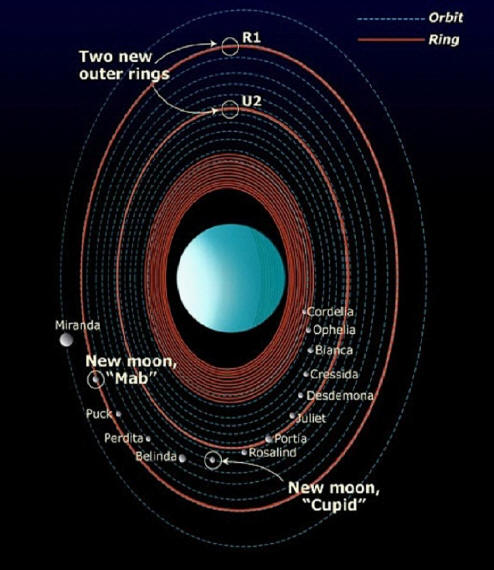
The rings and
moons of Uranus. Credit: NASA, ESA, and A. Field
of STScI.
Son of Gaea
Aug
25, 2010
One of
the largest planets in the Solar
System is also one of the most
enigmatic.
Uranus is the coldest planet in the
Solar System at -224° Celsius. The
refrigerated dwarf Pluto is colder,
but by consensus it has been
relegated to the planetesimal
category and no longer qualifies as
a fully fledged planet.
No one knows why Uranus is so
cold—colder than its more remote
neighbor Neptune at -214° Celsius.
Neptune lies at a mean distance from
the Sun of 4,504,300,000 kilometers
and Uranus at 2,870,990,000
kilometers, so it receives four
times less solar radiation. However,
astronomers think that the low
temperature anomaly on Uranus could
be due to its rotational vector.
Uranus
is tipped on its side by 97° past
vertical, prompting scientists to
speculate that the gas giant was
involved in a massive collision
sometime in its early history. It is
also thought that colliding with
that other large object might have
released much of its heat, although
the precise mechanism for how a
collision can cool down a planet
remains a mystery.
Uranus does not radiate a great deal
of energy in the infrared
wavelengths, so its interior is much
colder than that of Jupiter, for
instance. Based on observations by
the
Keck telescope,
Jupiter's infrared signature
corresponds to an internal
temperature of approximately 29727°
Celsius, whereas the internal
temperature of Uranus is about 4727°
Celsius. If the Sun were to
disappear tomorrow, Jupiter would
still be visible as a faint, reddish
glow, but Uranus would be almost
invisible against the black
background of space.
Like
its other gas giant siblings, Uranus
has a complex system of rings in
orbit with a bevy of satellites.
Currently, there are 27 known moons
circling the planet, ranging in size
from
Miranda
(470 kilometers in diameter) to
Titania
(1578 kilometers in diameter). The
most unusual thing about the rings
and moons is their placement.
Uranus is revolving around the Sun
while lying on its side, and its
moons and rings are also orbiting
along with it in the same
orientation. Instead of circling the
planet near the plane of the
ecliptic, they are inclined from the
vertical by 97°, perpendicular to
the rest of the Solar System.
However, there are several small
moons that orbit in the "correct"
angle of inclination, crossing from
axial pole to axial pole, as well as
moving in a retrograde fashion. Why
this is so is not known, although it
has been suggested that these moons
were "captured" by Uranus and did
not evolve with it out of a
hypothetical nebular cloud.
The
rings of Uranus are similar to those
around Saturn and Jupiter. Neptune
possesses a system of rings as well,
but they are thin and only partial,
appearing more like ring segments or
arcs than a complete set of
bracelets. There are at least 13
rings around Uranus,
with the potential for more as the
refurbished Hubble Space Telescope
turns its new eyes on the planet.
The
magnetic field generated by Uranus
is probably the most unusual aspect
of a planet whose structure is
dominated by eccentricities. Unlike
Saturn,
whose magnetic poles are aligned
almost exactly with its axial poles,
or
Jupiter,
whose field is offset from vertical
by a mere 10°, the magnetic poles of
Uranus are offset at a slant from
its rotational axis by 60°. Neptune
exhibits a similar field offset,
with the majority of the field
strength concentrated in one
hemisphere—like Uranus.
Why
Jupiter and Saturn have intense
magnetic fields, while Uranus and
Neptune have weak fields is not
understood by conventional
astronomers or by Electric Universe
theorists. In the Electric Universe
model, however, there is no
dependence on internal composition,
such as an iron core acting as a
dynamo, or a compressed core of
metallic hydrogen creating the field
through rapid rotation. What is most
likely occurring is that the rapid
rotation of charged particles in the
plasma making up the giant planets
is creating a powerful surge of
electromagnetic energy. It is common
knowledge that a rotating electrically
charged body will produce a magnetic
field.
All
four gas giant planets spin at
enormous velocities for their sizes.
Uranus is 51120 kilometers in
diameter, yet it completes one
rotation in just under 18 hours.
Recently, a current sheet was found
connecting Uranus with its moon
Miranda, feeding current into the
auroral field, proving that there is
an electric circuit within the
Uranian system. In fact, the
magnetosphere of Uranus extends out
beyond its farthest moon and is wide
enough to encompass its entire ring
system.
It is
to be hoped that outlining the
problems and anomalies associated
with one of the coldest of the cold
places in existence will motivate
more interest and more
investigation. We have made little
attempt to explain what is found on
Uranus because explanations have yet
to be forthcoming—electrical
conditions usually require in situ
measurements. So far, only one space
probe has visited Uranus, and the
Earth-based telescopes on the ground
and in orbit have just recently been
upgraded to the point where sharper
images can be synthesized. We can
only wait for more data.
Stephen Smith







